Table of Contents
The pull-up bar occurs in most gyms, but you can also find it outside on the workout spot. Maybe you even have it at home, but you don’t know much about the pull-up bar workout. Many people think that it’s for men only, namely the strongest ones. After reading this article, you will for sure understand that this is not really the case.
The pull-up bar can serve for so much more than just pull-ups, muscle-ups, or other acrobatic stunts. There are other easier exercises suitable for almost everyone. In the article, you’ll learn how to perform them. You can then use them to diversify your training and give your body a new muscle and functional strength development impulse.
Why is it beneficial to exercise on the pull-up bar?
The popularity of pull-up bar exercises is growing with the number of newly built workout spots and also because it’s an available training aid for home gyms. Thus, you can train on the pull-up bar not only in the gym but also at home or outdoors. You can as well place it above the door and your mini home gym is ready. The big advantage is that you don’t need anything other than your own body. You can as well pack some extra expander to help you perform the exercises.
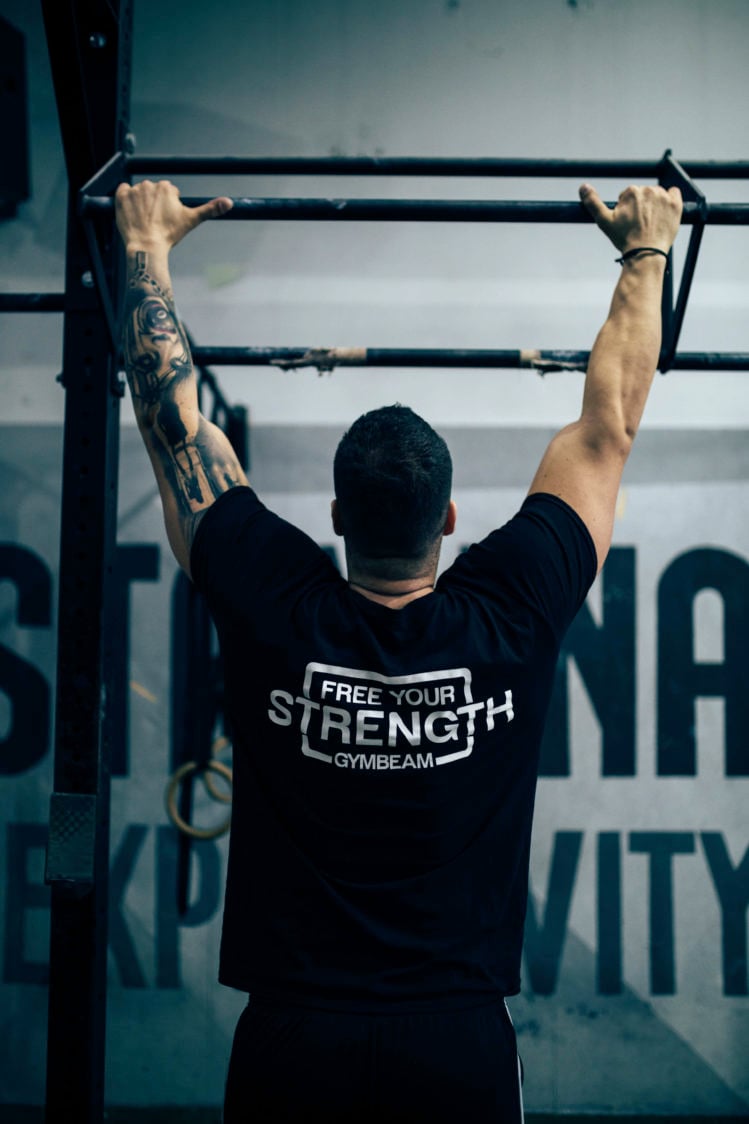
When exercising on the pull-up bar, you develop functional strength. This will come in handy during dumbbell training and in everyday life. It is because your muscles will work more effectively together with the nervous system, and thus be better involved. [1]
Regular pull-up bar training will probably not make you Arnold Schwarzenegger, but you can definitely expect some muscle gains. Just look, for example, at Frank Medran and other sportsmen who practice callisthenics. They have built their bodies on the pull-up bar.
The pull-up bar will help you strengthen the muscles of your arms (shoulders, biceps, triceps, forearms) and also back, chest and abs. You will not only achieve a well-defined figure but also a better posture. On top of that, you will have a stronger grip which you can use when deadlifting, for example. [2-3]
This type of training has, of course, other advantages, just like almost every physical activity. It will not only help you build muscle mass but you will also burn a decent amount of calories, thus support weight loss.
You will also improve your physical condition and mobility, such as coordination, balance, or flexibility.
Any physical activity has a positive impact on your physical as well as mental health. You most likely know that amazing post-workout feeling. It is caused by endorphins (the happiness hormones). They make you so happy and confident that you feel motivated to exercise again. [3–5]
How to train on the pull-up bar?
You don’t have to worry about the pull-up bar exercises even when you’re a beginner. If you exercise regularly, you will soon see some great results.
- Most of the pull-up bar exercises can be tailored to your ability. If you want to make them easier, use a resistance band, aka expander. It will reduce the load and help you fight gravity. If, on the other hand, the basic exercises are just too easy for you, add some load and move on to the next level. You can try to train with a weighted vest, or attach weight straps to your ankles. Another option is a belt with a plate or kettlebell hanging on it.
- Include training of selected exercises regularly, at least twice a week. In the beginning, it is enough to do only a few repetitions (for example, 6-12 exercises, 3-5 sets). Increase these numbers as you gradually improve.
- Try to perform every exercise slowly while controlling your movement. A correct performance should be your priority, not the number of reps. You will only improve by mastering the technique. You will learn to engage the right muscles, and you will prevent injuries and possible muscle imbalances.
- In short, you don’t have to spend the whole training on the pull-up bar immediately. You can choose just some of the exercises below and include them in your training. For example, you will need the wide-grip overhand pull-ups to work out your back muscles, while when exercising the biceps, choose the chin-ups. And you can add knee lift or L-sit to your favourite ab exercises.
- When you decide to train on the pull-up bar, bring the suspension trainer or gymnastic rings with you. You can easily attach these exercise aids to the pull-up bar and effectively work your arms, the core of the body and legs. This will alter your training even more. At the same time, you will engage the muscles you would just on the pull-up bar. [6]
If you are looking for other ways to strengthen the core of the body, try the training in our article How to Exercise with the Suspension Trainer? Try These Effective Full-Body Exercises.
You might be interested in these products:
10 Basic Pull-Up Bar Exercises for Strong Arms, Back and Abs
Don’t forget to warm up slightly before the training (running on the spot or jumping rope). Then warm up your whole body by doing a circular motion in your large joints. After the main part, take a few minutes to stretch.
The exercises below will effectively strengthen your entire upper body. Some of them, such as the scapular pull-ups, or negative pull-ups, will help you on your way to your first pull-up. And if you can’t manage to do it yet, take an expander to help you.
1. Scapular Pull-Ups
- Starting position: Grab the bar with a wider than shoulder-width overhand grip (the palms are facing away from you). Activate your core and let your legs hang naturally.
- Performance: Pull your shoulder blades together and your shoulders away from your ears while exhaling using a controlled motion. Remain in the upper position for a second, then return to the starting position and repeat the movement.
- Common mistakes: Swinging, uncontrolled movement, insufficient or excessive range of motion.
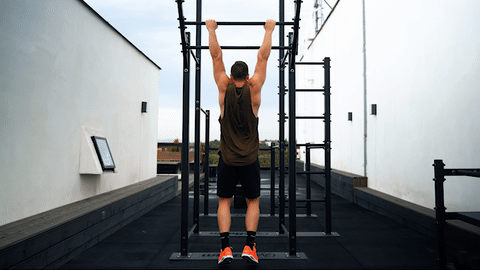
2. Negative Pull-Ups
- Starting position: Grab the bar with the wider than the shoulder-width overhand grip and get to the upper pull-up position (feel free to jump on it or use a plyometric box). Activate the core of the body as well as the muscles of your back and arms.
- Performance: Start coming down to the lower pull-up position as slow as possible while exhaling. Once your elbows are almost stretched, stand on the box or the ground. Come back to the starting position and repeat the movement.
- Common mistakes: Coming down too quickly, uncontrolled movement, swinging, insufficient or excessive activation of the muscles of the back, arms and abs.

3. Chin-Ups
- Starting position: Grab the bar with a shoulder-width underhand grip (the palms are facing you). Let your legs hang, or bend them and cross over each other. Activate your core.
- Performance: Pull your shoulder blades together and activate the muscles of your back and arms while exhaling. Start pulling yourself up. Your chest is facing the bar. Once your head is slightly above the bar, start slowly coming down while inhaling. Come back to the starting position, keep your shoulders blades back and down. Repeat the pull-up.
- Common mistakes: Swinging, insufficient range of motion, round back in the upper position, shoulders are up and helping yourself with legs.

4. Narrow Pull-Ups
- Starting position: Grab the bar with a little wider than shoulder-width overhand grip (the palms are facing away from you). Let your legs hang, or bend them and cross over each other. Activate your core.
- Performance: Pull your shoulder blades together and activate the muscles of your back and arms while exhaling. Start pulling yourself up. Your chest is facing the bar. Once your head is slightly above the bar, start slowly coming down while inhaling. Come back to the starting position, keep your shoulders blades back and down. Repeat the pull-up.
- Common mistakes: Swinging, insufficient range of motion, round back, shoulders are up, helping yourself with legs.
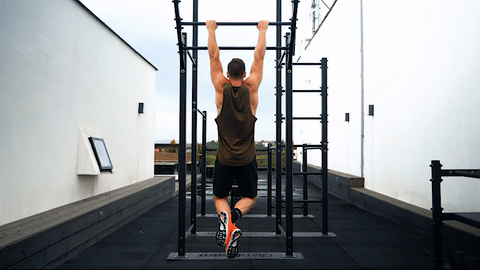
5. Wide Pull-Ups
- Starting position: Grab the bar with a wider than shoulder-width overhand grip (the palms are facing away from you). Let your legs hang, or bend them and cross over each other. Activate your core.
- Performance: Pull your shoulder blades together and activate the muscles of your back and arms while exhaling. Start pulling yourself up. Your chest is facing the bar. Once your head is slightly above the bar, start slowly coming down while inhaling. Come back to the starting position, keep your shoulders blades back and down. Repeat the pull-up.
- Common mistakes: Swinging, insufficient range of motion, round back, shoulders are up, helping yourself with legs.

6. Hanging Knee Raises
- Starting position: Grab the bar with a wider than shoulder-width overhand grip (the palms are facing away from you). Pull your shoulder blades together and stretch your legs.
- Performance: Activate your abs while exhaling and raise your knees toward your torso. Your shoulder blades remain down during the whole exercise. Come back to the starting position while inhaling. Repeat the movement.
- Common mistakes: Swinging, uncontrolled movement, shoulder blades are up, helping yourself with legs.
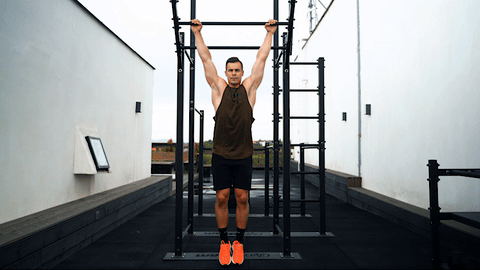
7. Hanging Oblique Knee Raises
- Starting position: Grab the bar with a wider than shoulder-width overhand grip (the palms are facing away from you). Pull your shoulder blades together and stretch your legs.
- Performance: Raise your knees obliquely toward your torso by activating your abs while exhaling. Your knees almost touch your armpits. Your shoulder blades remain down during the whole exercise. Extend your legs while inhaling and come back to the starting position. Repeat the movement to the other side.
- Common mistakes: Swinging, uncontrolled movement, shoulder blades are up, helping yourself with legs.
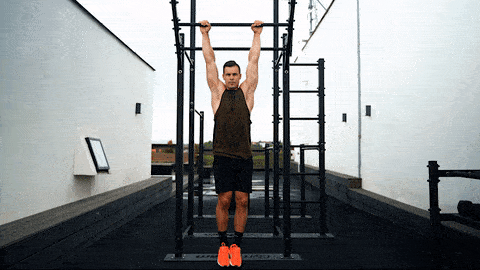
8. Hanging Straight Leg Raises
- Starting position: Grab the bar with a wider than shoulder-width overhand grip (the palms are facing away from you). Pull your shoulder blades together and stretch your legs.
- Performance: Raise your legs extended until they create a right angle with your body (or until your body allows) by activating your abs while exhaling. Remain one second in this position and then start lowering your legs with a controlled movement while inhaling. Repeat the movement.
- Common mistakes: Swinging, uncontrolled movement, shoulder blades are up, insufficient range of motion.
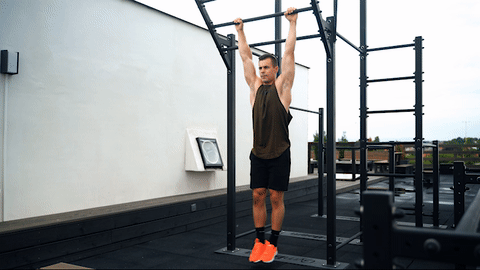
9. Hanging L-Sit
- Starting position: Grab the bar with a wider than shoulder-width overhand grip (the palms are facing away from you). Pull your shoulder blades together and stretch your legs.
- Performance: Raise your legs extended until they create a right angle with your body (or until your body allows) by activating your abs while exhaling. Remain in this position as long as possible and then lower your legs down. Repeat the movement.
- Common mistakes: Uncontrolled movement and excessive swinging, shoulder blades are up, remaining in the upper position for too little.
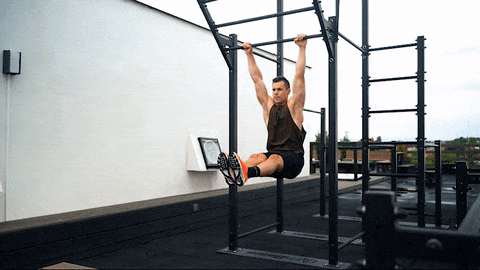
10. Toes to Bar
- Starting position: Grab the bar with a wider than shoulder-width overhand grip (the palms are facing away from you). Pull your shoulder blades together and stretch your legs.
- Performance: Try to touch the bar with your legs extended by activating your abs while exhaling. Slowly come back to the starting position and repeat the movement.
- Common mistakes: Swinging, uncontrolled movement, shoulder blades are up, insufficient range of motion.

What should you remember?
You can exercise almost anywhere on the pull-up bar. All you have to do is go to the gym or a nearby workout spot. When you want to work out at home, place it at the door or attach it to the ceiling. It will allow you to perform various pull-up variations, as well as many effective ab exercises. The pull-up bar workout will improve your posture, strengthen your arms, back, and abs. Moreover, you will gain more functional strength and thus better control over your muscles.
In addition, the pull-up bar exercise is very effective, and if you persevere with it, you will soon notice an improvement and increase in the mass of the back muscles. You can then manage, for example, more repetitions of the given exercise, or you will perform it better. It is an easy way to improve the condition of your body and mind.
If you liked the article, don’t forget to share it with your friends. They will for sure appreciate tips on pull-up bar exercises.
[1] Fit People. Advantages of Bar Workouts– https://fitpeople.com/fitness/advantages-of-bar-workouts/
[2] 7 Reasons to do pullups every day. – https://livefit.com/blogs/livefit/7-reasons-to-do-pullups-every-day
[3] WebMD. Calisthenic Benefits. – https://www.webmd.com/fitness-exercise/benefits-calisthenics
[4] 11 Benefits of Calisthenics Training | OriGym. (b.r.). Získáno 12. srpen 2021, z https://origympersonaltrainercourses.co.uk/blog/benefits-of-calisthenics
[5] Ruegsegger, G. N., & Booth, F. Health Benefits of Exercise. – https://doi.org/10.1101/cshperspect.a029694
[6] Fit&Me. 10 Benefits of Pull Ups That Will Have You Reaching For The Sky. – https://www.fitandme.com/benefits-of-pull-ups/

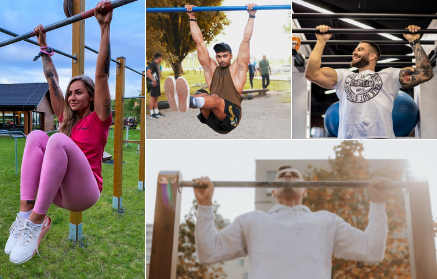
Add a comment